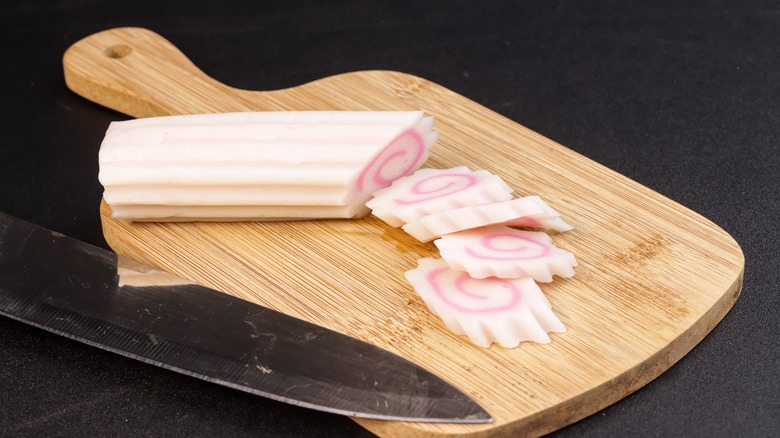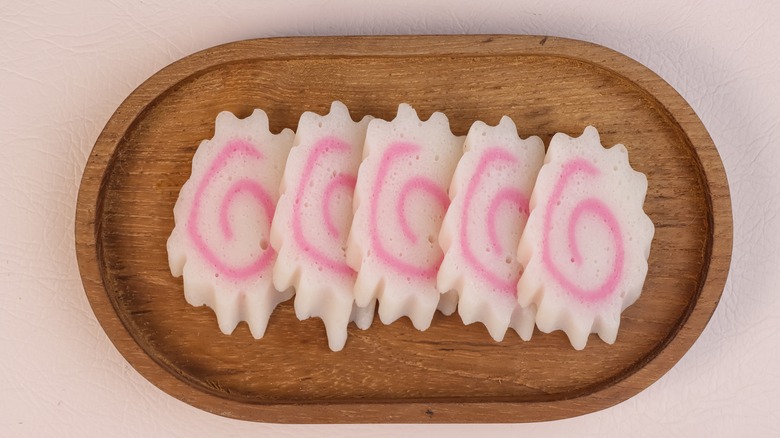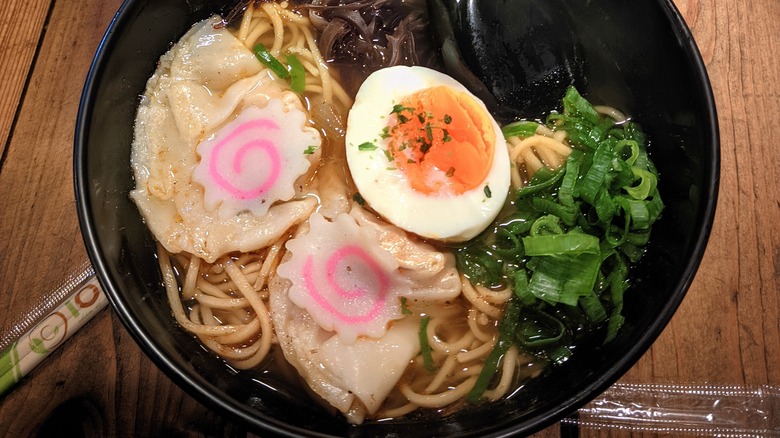What Are Fish Cakes, And Why Are They In Your Ramen?
Prepared in the classic Japanese style, ramen is a comfort dish loaded with flavor. It's no surprise the dish is surging in restaurant popularity over recent years, with several qualities contributing to its easy-to-love nature. While the magic is impossible to pin down, an attribute that undoubtedly enhances the appeal is ramen's diverse range of toppings.
Just glance at the bowl of broth and noodles, and you'll find an assembly of delicious components like jammy, soy-marinated eggs, some meaty pork chashu, nori, and marinated bamboo menma aesthetically laid on top. Especially eye-catching are narutomaki, or the vibrant white ridged fish cakes with pink swirls. By way of its unique appearance, the foodstuff inspires curiosity to those unfamiliar. Made of a fish paste seasoned with sugar, salt, and other ingredients, it's a shelf-stable ingredient uncommon in the U.S. However, this fish cake style packs in a remarkable appeal worth investigating.
Japanese fish cakes are composed of a flavored fish paste
Narutomaki is a special type of kamaboko, a category of Japanese fish cakes. Enjoyed for centuries, this processed food type boils, fries, or steams fish paste into a stable form that doesn't require refrigeration. Narutomaki comes together using the white-fleshed fish-based surimi, a method of processing also used for imitation crab. Fillets are washed, then cut into small pieces and combined with sugar, a method that creates a dense and chewy texture. The fish cake is then steamed, creating an extra-firm consistency.
The prepared fish comes out naturally white, however, a portion is set aside and dyed red. The paste is rolled into a cylinder, with the red coloration creating a swirl on cross-section cuts. Simultaneously, the exterior is pressed into a bamboo mat, creating exterior ridges. Such a distinct appearance is said to have been created to replicate tide pools off the Japanese coast of Naruto, hence lending the food its name. So today, narutomaki continues to add its eye-catching design onto noodle bowls worldwide.
Narutomaki is typically eaten with noodles
Much like cooking with imitation crab meat, one of the advantages of narutomaki is that it doesn't require heat preparation. Furthermore, its pleasantly savory, fishy, and slightly sweet flavor melds terrifically with other ingredients. The fish cake also offers a pleasant chew, contrasting other ramen elements. As a result, such factors make the fish cake an ideal candidate for topping noodle bowls.
These fish cakes are most associated with being a ramen topping, hence why you so frequently see narutomaki on ramen. The aesthetically-pleasing cakes enhance noodle bowls with texture and color without much added effort. Plus, it'll mingle with different broths, from a more gently flavored shio or shoyu to an extra-spicy beef ramen. And while ramen-style noodles are a more common vessel for narutomaki fish cakes, you'll also find them adding a colorful dash to udon, too. So next time you see narutomaki in your ramen bowl, know that it's a storied pairing, and enjoy it to the fullest.


